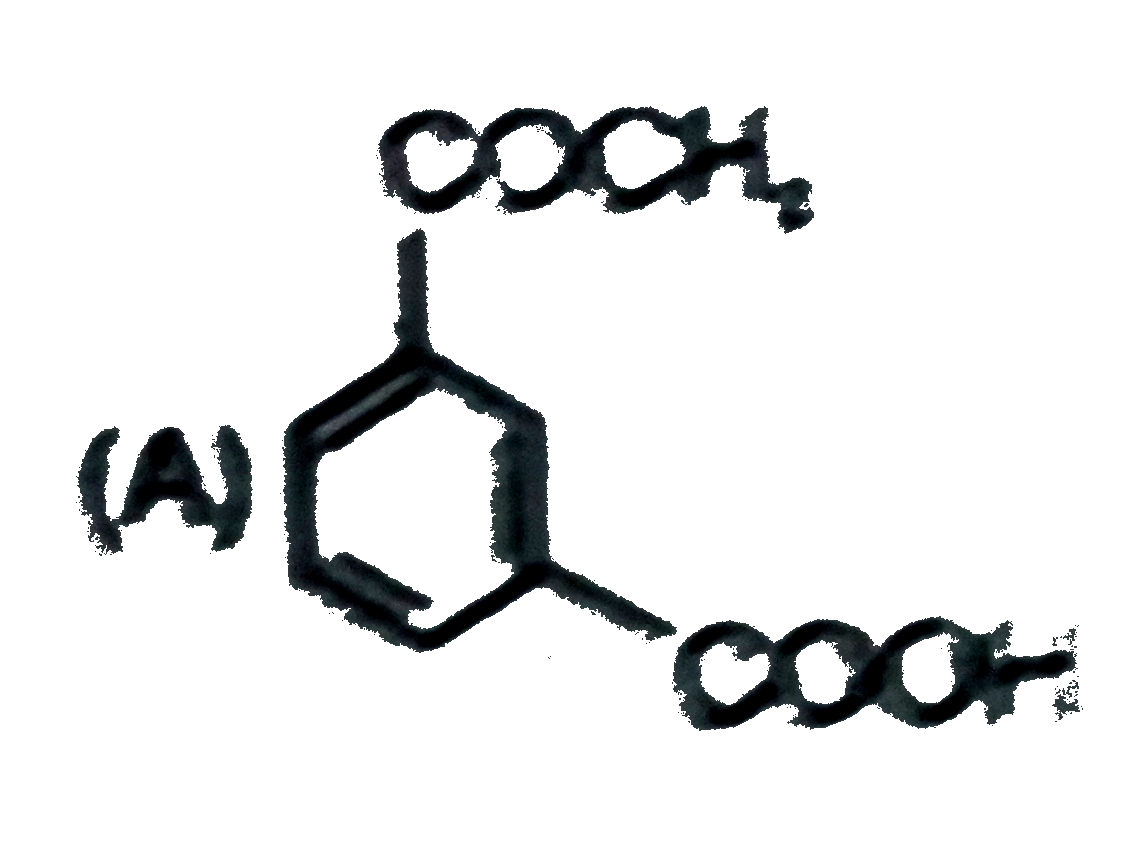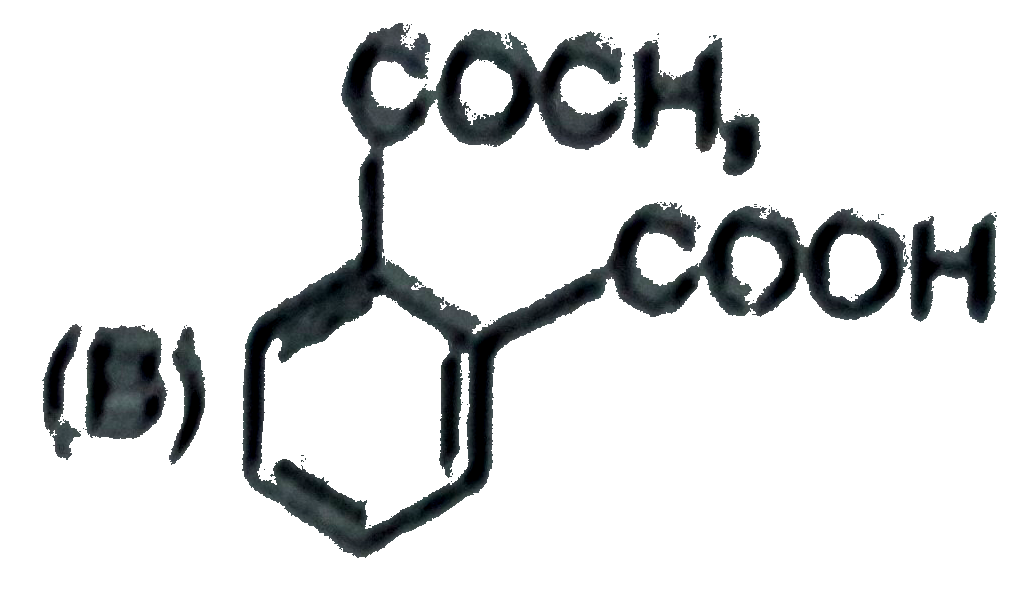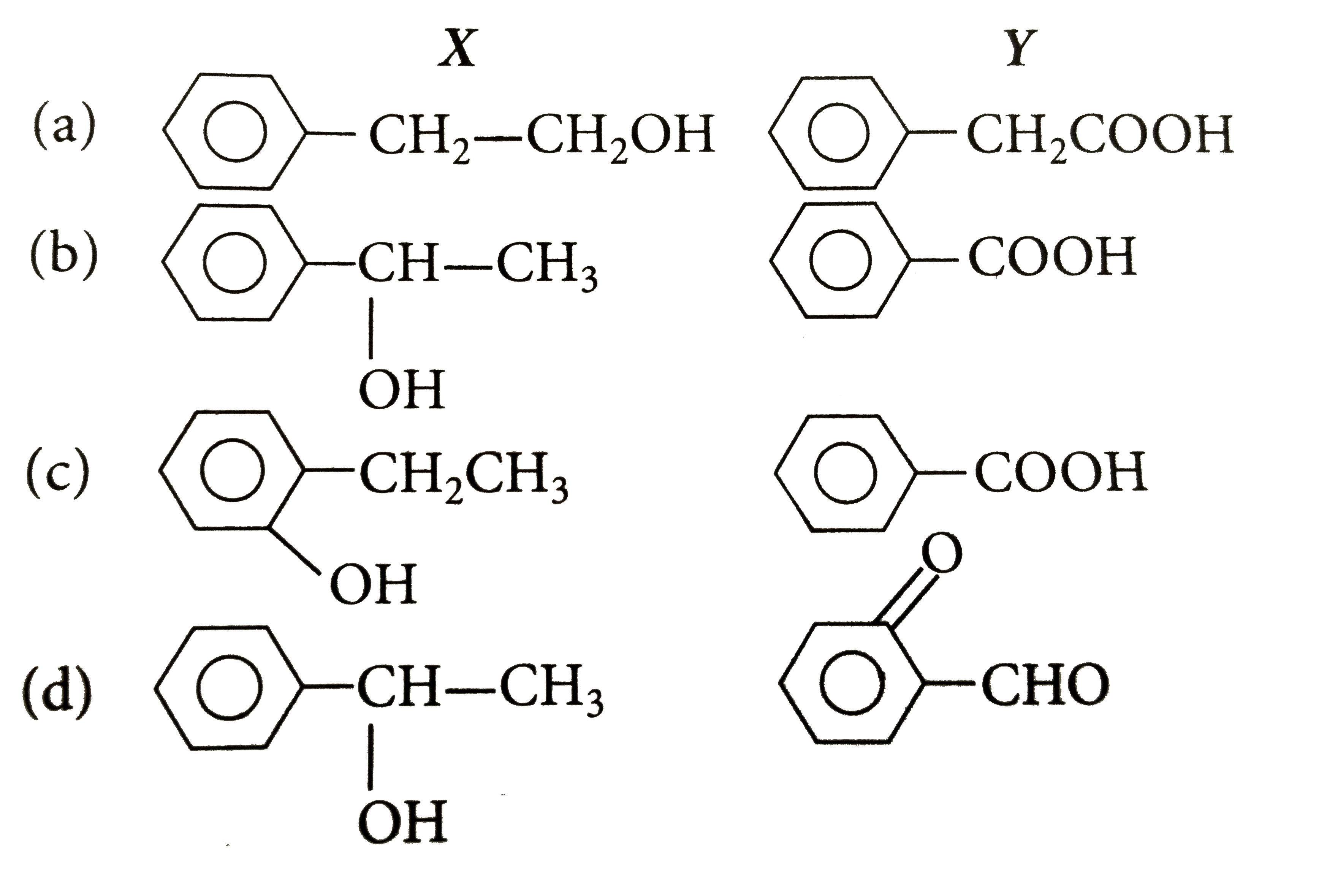An aromatic compound 'X' (C9H8O3) turns blue litmus to red.It gives yellow precipitate with I2/NaOH and forms Y (C8H5O4). Y forms three mononitro isomeric products. Identify X.



None of these
The correct Answer is:A
To identify the aromatic compound 'X' with the molecular formula C9H8O3, we can follow these steps:
Step 1: Analyze the Molecular Formula
The molecular formula C9H8O3 indicates that the compound is likely aromatic due to the presence of a benzene ring. The degree of unsaturation can be calculated, which suggests that there are multiple rings or double bonds.
Hint: Look for the presence of a benzene ring in the structure.
Step 2: Identify Functional Groups
The problem states that 'X' turns blue litmus paper red, indicating that it is acidic. This suggests the presence of a carboxylic acid group (-COOH) in the structure.
Hint: Remember that only acidic compounds can turn blue litmus red.
Step 3: Iodoform Test
The compound gives a yellow precipitate with iodine and sodium hydroxide (NaOH), which is characteristic of the iodoform test. This test indicates the presence of a methyl ketone (R-CO-CH3) or a secondary alcohol adjacent to a methyl group.
Hint: The iodoform test is a key indicator of specific functional groups.
Step 4: Construct Possible Structures
Considering the above points, we can deduce that 'X' must contain:
- A benzene ring
- A carboxylic acid group (-COOH)
- A methyl group attached to a carbonyl (ketone) or a secondary alcohol.
This leads us to propose a structure like:
- C6H4(COOH)(COCH3)
Hint: Combine the functional groups logically to form a stable aromatic compound.
Step 5: Verify the Structure
The proposed structure must satisfy the molecular formula C9H8O3:
- 6 carbons from the benzene ring
- 1 carbon from the carboxylic acid
- 2 carbons from the methyl ketone
This gives a total of 9 carbons, which matches the formula.
Step 6: Identify Compound Y
When 'X' reacts with iodine and NaOH, it forms 'Y' with the formula C8H5O4. This suggests that one of the substituents is removed or transformed during the reaction.
Hint: Keep track of how the reaction alters the structure.
Step 7: Nitration of Compound Y
The problem states that 'Y' can form three mononitro isomers upon nitration. The positions of the substituents on the benzene ring will determine the possible positions for the nitro group.
Hint: Consider ortho and para positions for the nitro group relative to the existing substituents.
Step 8: Conclusion
After analyzing all the steps, we conclude that the structure of 'X' is likely:
- X = 4-hydroxy-3-methylbenzoic acid (or p-hydroxy-methylbenzoic acid)
Thus, the final identification of compound 'X' is:
Answer: C6H4(COOH)(COCH3) or specifically, 4-hydroxy-3-methylbenzoic acid.
The molecular formula C9H8O3 indicates that the compound is likely aromatic due to the presence of a benzene ring. The degree of unsaturation can be calculated, which suggests that there are multiple rings or double bonds.
The problem states that 'X' turns blue litmus paper red, indicating that it is acidic. This suggests the presence of a carboxylic acid group (-COOH) in the structure.
The compound gives a yellow precipitate with iodine and sodium hydroxide (NaOH), which is characteristic of the iodoform test. This test indicates the presence of a methyl ketone (R-CO-CH3) or a secondary alcohol adjacent to a methyl group.
Considering the above points, we can deduce that 'X' must contain:
- A benzene ring
- A carboxylic acid group (-COOH)
- A methyl group attached to a carbonyl (ketone) or a secondary alcohol.
- C6H4(COOH)(COCH3)
The proposed structure must satisfy the molecular formula C9H8O3:
- 6 carbons from the benzene ring
- 1 carbon from the carboxylic acid
- 2 carbons from the methyl ketone
When 'X' reacts with iodine and NaOH, it forms 'Y' with the formula C8H5O4. This suggests that one of the substituents is removed or transformed during the reaction.
The problem states that 'Y' can form three mononitro isomers upon nitration. The positions of the substituents on the benzene ring will determine the possible positions for the nitro group.
After analyzing all the steps, we conclude that the structure of 'X' is likely:
- X = 4-hydroxy-3-methylbenzoic acid (or p-hydroxy-methylbenzoic acid)
Topper's Solved these Questions
Similar Questions
An aromatic compound 'A' (Molecular formula C8H8O)) gives positive 2, 4-DNP test. It gives a yellow precipitate of compound 'B' on treatment with iodine and sodium hydroxide solution. Compound 'A' does not give Tollen's or Fehling's test. On drastic oxidation with potassium permanganate, it forms a carboxylic acid 'C' (Molecular formula C7H6O2), which is also formed along with the yellow compound in the above reaction. Identify A, B and C and write all the reactions involved.
View SolutionAn aromatic compound T (C10H10O2) gives 2 moles of CHI2 and compound U (C8H4O4Na) on treatment with I2.and NaOH . After acidification U gives two mononitro products on nitration.
Compound U is
View Solution
Knowledge Check
An aromatic compound (X) (C8H8O) gives positive 2, 4-DNP test. It gives a yellow precipitate of compound (Y) on reaction with iodine and sodium hydroxide solution. (X) does not give Tollens' test on oxidation under drastic conditions. It gives a carboxylic acid (Z) (C7H6O2).(Z) is also formed with (Y) during the reaction. (X), (Y) and (Z) respectively are
AC6H5COCH3,CHI3,C6H5COOHBCH3COCH3,CHI3,CH3COOHCC6H5COCH3,CHI3,CH3COOHDCH3CHO,CHI3,C6H5COOHUnknown compound (A) C5H10O give positive test with 2,4 - DNP
but negative test with Tollen's reagent. It also give yellow precipitate with I2/NaOH . (A) is :A B
B C
C D
D
An aromatic compound A of the molecular formula C8H10O on reaction with iodine and dilute NaOH gives a yellow precipitate. The structure of the compound is expected to be :
A BC6H5CHOHCH3C
BC6H5CHOHCH3C D
D
An aromatic compound 'A' (molecular formula C8H8O) gives positive 2, 4-DNP test. It gives a yellow precipitate of compound 'B' on treatment with iodine and sodium hydroxide solution. Compound 'A' does not give Tollen's or Fehling's test. On drastic oxidation with potassium permaganate it forms a carboxylic acid 'C' (molecular formula C7H6O2), which is also formed alongwith the yellow compound in the above reaction. Identify A, B and C and write all the reactions involved.
View SolutionAn aromatic compound 'A' (molecular formula C8H8O) gives positive 2, 4-DNP test. It gives a yellow precipitate of compound 'B' on treatment with iodine and sodium hydroxide solution. Compound 'A' does not give Tollen's or Fehling's test. On drastic oxidation with potassium permaganate it forms a carboxylic acid 'C' (molecular formula C7H6O2), which is also formed alongwith the yellow compound in the above reaction. Identify A, B and C and write all the reactions involved.
View SolutionAn aromatic compound 'A' (molecular formula C8H8O) gives positive 2, 4-DNP test. It gives a yellow precipitate of compound 'B' on treatment with iodine and sodium hydroxide solution. Compound 'A' does not give Tollen's or Fehling's test. On drastic oxidation with potassium permaganate it forms a carboxylic acid 'C' (molecular formula C7H6O2), which is also formed alongwith the yellow compound in the above reaction. Identify A, B and C and write all the reactions involved.
View SolutionA compund X(C8H10O) upon treatment with alkaline solution of iodine gives a yellow precipitate. The filtrate on acidifiction gives a whit solid Y(C7H6O2) Write the strctures of X and Y.

View SolutionX' compound (C4H8O) decolorises bromine water react with I2 & NaOH it give yellow ppt identify 'X'
View Solution
